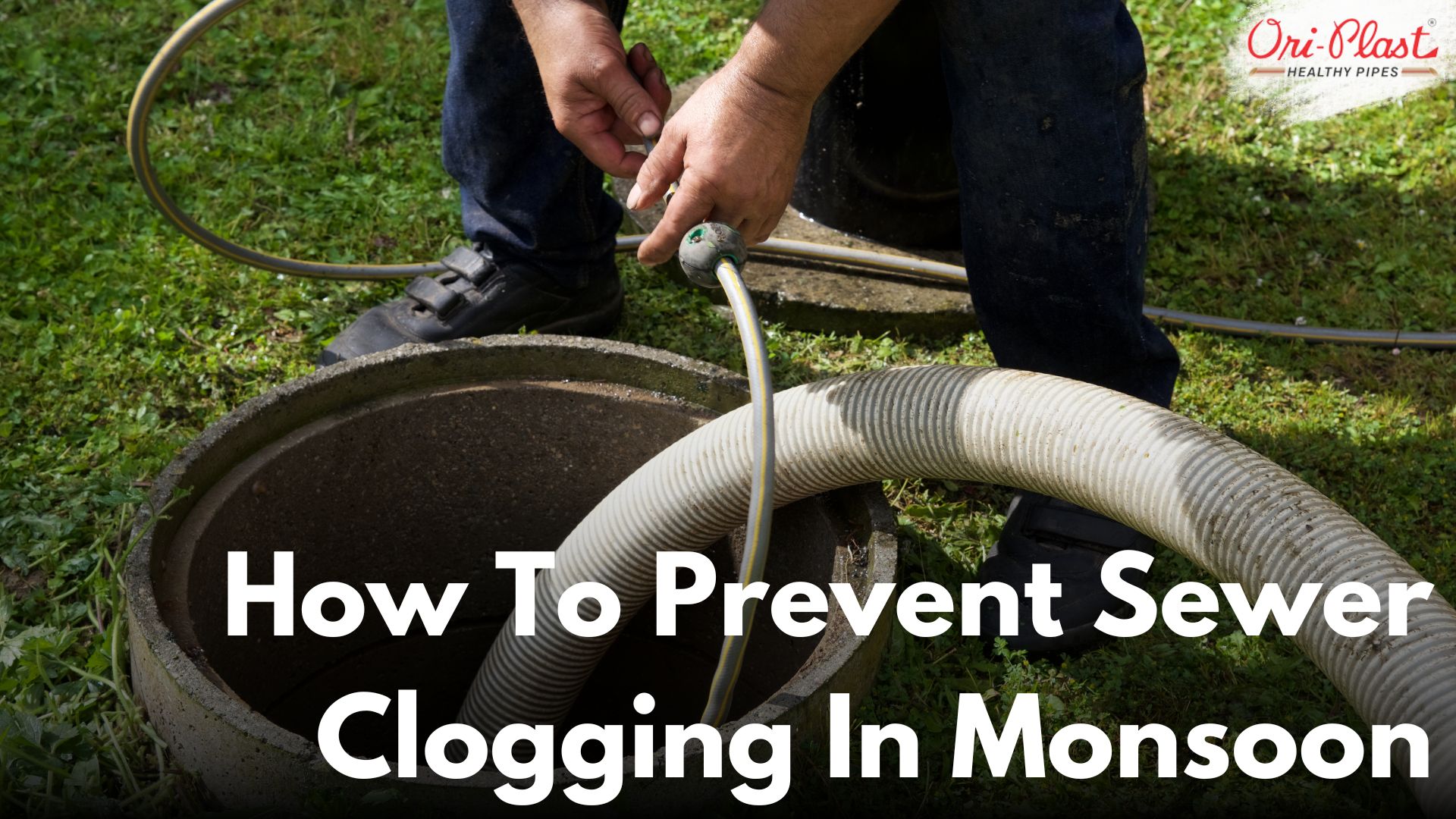The monsoon season brings much-needed relief from the summer heat, but it also brings with it a set of challenges, particularly for our sewer systems. Heavy rains can overwhelm drainage systems, leading to sewer clogging and the subsequent risk of flooding. Preventing sewer clogging during the monsoon is crucial to avoid these problems and maintain a hygienic and safe environment.
In this blog, we'll delve into the causes of sewer clogging, the impact it can have, and most importantly, effective strategies to prevent it. By understanding and implementing these strategies, you can help ensure that your local sewer system remains functional and efficient throughout the monsoon season.
Understanding Sewer Clogging
What Causes Sewer Clogging?
Sewer clogging occurs when debris, waste, or other materials obstruct the flow of water through the sewer pipes. During the monsoon, the risk of clogging increases due to the heavy rainfall and the additional debris washed into the sewers. Common causes include:
- Leaves and Plant Debris: Fallen leaves, twigs, and other plant matter can be washed into the drains, leading to blockages.
- Mud and Silt: Heavy rains can wash soil and silt into the drainage system, which can accumulate and cause blockages.
- Solid Waste: Improper disposal of solid waste, such as plastic bags, bottles, and other non-biodegradable items, can clog the sewers.
- Grease and Oil: Fats, oils, and grease from kitchens can solidify in the pipes, reducing their diameter and leading to blockages.
- Construction Debris: Materials like cement, sand, and stones from construction sites can be washed into the sewers and cause significant blockages.
The Impact of Sewer Clogging
Sewer clogging during the monsoon can lead to a variety of problems, including:
- Flooding: Blocked sewers can cause water to back up and flood streets, homes, and businesses.
- Health Hazards: Stagnant water and overflowing sewage can create breeding grounds for mosquitoes and other pests, increasing the risk of diseases.
- Property Damage: Flooding can cause extensive damage to properties, including structural damage and loss of personal belongings.
- Environmental Pollution: Overflowing sewers can contaminate local water bodies, harming aquatic life and affecting water quality.
Preventative Measures: Keeping Sewers Clear During Monsoon
Regular Maintenance and Cleaning
One of the most effective ways to prevent sewer clogging is through regular maintenance and cleaning. Municipal authorities and property owners should ensure that sewer lines and drains are inspected and cleaned regularly, especially before the monsoon season begins.
Steps for Regular Maintenance
- Inspection: Regularly inspect sewer lines and drains for any signs of blockage or damage.
- Cleaning: Use high-pressure water jets or mechanical cleaners to remove debris, silt, and other obstructions from the pipes.
- Repair: Fix any cracks, leaks, or damaged sections of the sewer system to prevent further issues.
Proper Waste Disposal
Ensuring proper waste disposal is crucial to preventing sewer blockages. Both residents and businesses should be educated about the importance of disposing of waste correctly.
Tips for Proper Waste Disposal
- Segregate Waste: Separate biodegradable and non-biodegradable waste and dispose of them accordingly.
- Avoid Flushing Non-Biodegradable Items: Do not flush items like plastic bags, sanitary napkins, diapers, or wipes down the toilet.
- Dispose of Grease Properly: Avoid pouring grease and oil down the sink. Instead, collect it in a container and dispose of it in the trash.
- Use Garbage Disposals Carefully: Do not overload garbage disposals with large amounts of food waste, especially fibrous or starchy foods that can cause blockages.
Community Involvement and Awareness
Community involvement and awareness are key to preventing sewer clogging. By working together, communities can ensure that everyone is doing their part to keep the sewer system clear.
Ways to Promote Community Involvement
- Educational Campaigns: Organize awareness campaigns to educate residents about the causes and prevention of sewer clogging.
- Community Clean-Up Drives: Encourage community members to participate in clean-up drives to remove litter and debris from streets and drains.
- Reporting Issues: Create a system for residents to report clogged drains or sewer issues to the local authorities promptly.
Use of Protective Grates and Screens
Installing protective grates and screens over drains can help prevent large debris from entering the sewer system. These can be particularly effective in areas prone to heavy leaf fall or where there is a lot of foot traffic.
Benefits of Protective Grates and Screens
- Debris Prevention: Prevents large debris like leaves, twigs, and trash from entering the drains.
- Easy Maintenance: Grates and screens can be easily removed and cleaned, making maintenance simpler.
- Cost-Effective: Installing grates and screens is a relatively low-cost measure that can prevent expensive blockages.
Landscaping and Urban Planning
Proper landscaping and urban planning can play a significant role in preventing sewer clogging. By designing green spaces and drainage systems thoughtfully, cities can reduce the risk of blockages.
Landscaping Tips
- Use Permeable Materials: Use permeable paving materials that allow water to seep through and reduce runoff.
- Plant Trees Strategically: Plant trees and shrubs in areas where their roots will not interfere with sewer lines.
- Create Rain Gardens: Develop rain gardens to absorb rainwater and reduce the amount of runoff entering the sewer system.
Urban Planning Strategies
- Improved Drainage Systems: Design and implement efficient drainage systems that can handle heavy rainfall.
- Retention Ponds and Basins: Construct retention ponds and basins to temporarily hold excess rainwater and prevent overloading the sewers.
- Green Roofs and Walls: Encourage the use of green roofs and walls to absorb rainwater and reduce runoff.
Emergency Measures: What to Do If Sewer Clogging Occurs
Despite all preventative measures, sewer clogging can still occur. It's important to know what to do in case of an emergency to minimize damage and restore normalcy as quickly as possible.
Immediate Actions
- Report the Issue: Immediately report the clog or overflow to the local municipal authorities.
- Avoid Contact with Sewage: Stay away from any areas where sewage has overflowed to avoid health risks.
- Protect Your Property: Use sandbags or barriers to prevent sewage water from entering your home or business.
- Turn Off Utilities: If flooding is severe, turn off gas, electricity, and water supplies to prevent accidents.
Professional Help
Hiring professional help is often necessary to deal with severe sewer clogs. Professional plumbers and sewer maintenance companies have the expertise and equipment to handle complex blockages.
Services Offered by Professionals
- Sewer Inspection: Use of cameras and other equipment to inspect sewer lines and identify the cause of the blockage.
- High-Pressure Jetting: Use of high-pressure water jets to clear blockages and clean sewer pipes.
- Repair and Replacement: Repairing or replacing damaged sections of the sewer system to restore functionality.
Clean-Up and Disinfection
After the blockage is cleared, it's crucial to clean and disinfect any areas affected by sewage overflow to prevent health hazards.
Clean-Up Steps
- Remove Water and Debris: Use pumps and vacuums to remove standing water and debris.
- Clean Surfaces: Clean all surfaces with soap and water, followed by a disinfectant.
- Dry the Area: Use fans and dehumidifiers to thoroughly dry the affected area to prevent mold growth.
- Dispose of Contaminated Items: Safely dispose of any items that have been contaminated by sewage and cannot be cleaned.
Long-Term Strategies for Sewer System Improvement
Upgrading Infrastructure
Investing in upgraded infrastructure is essential for long-term prevention of sewer clogging. Modernizing the sewer system can significantly enhance its capacity and efficiency.
Infrastructure Upgrades
- Larger Pipes: Installing larger diameter pipes to handle increased water flow.
- Modern Materials: Using durable, corrosion-resistant materials for pipes and fittings.
- Advanced Treatment Plants: Upgrading sewage treatment plants to handle higher volumes of waste more efficiently.
Implementing Sustainable Practices
Adopting sustainable practices can reduce the burden on the sewer system and promote environmental conservation.
Sustainable Practices
- Rainwater Harvesting: Implementing rainwater harvesting systems to reduce runoff and supplement water supply.
- Greywater Recycling: Using greywater recycling systems to reuse water from sinks, showers, and laundry for irrigation and flushing toilets.
- Green Infrastructure: Developing green infrastructure projects like green roofs, permeable pavements, and urban forests to manage stormwater naturally.
Government Policies and Regulations
Effective government policies and regulations are crucial to ensuring the proper functioning of sewer systems and preventing blockages.
Key Policies
- Strict Waste Disposal Laws: Enforcing strict laws on waste disposal to prevent improper disposal of solid waste and hazardous materials.
- Regular Monitoring and Maintenance: Mandating regular monitoring and maintenance of sewer systems by local authorities.
- Funding and Grants: Providing funding and grants for infrastructure upgrades and sustainable projects.
Conclusion
Preventing sewer clogging during the monsoon season requires a collaborative effort from individuals, communities, businesses, and government authorities. By understanding the causes of sewer clogging and implementing effective preventative measures, we can ensure that our sewer systems remain functional and efficient,




